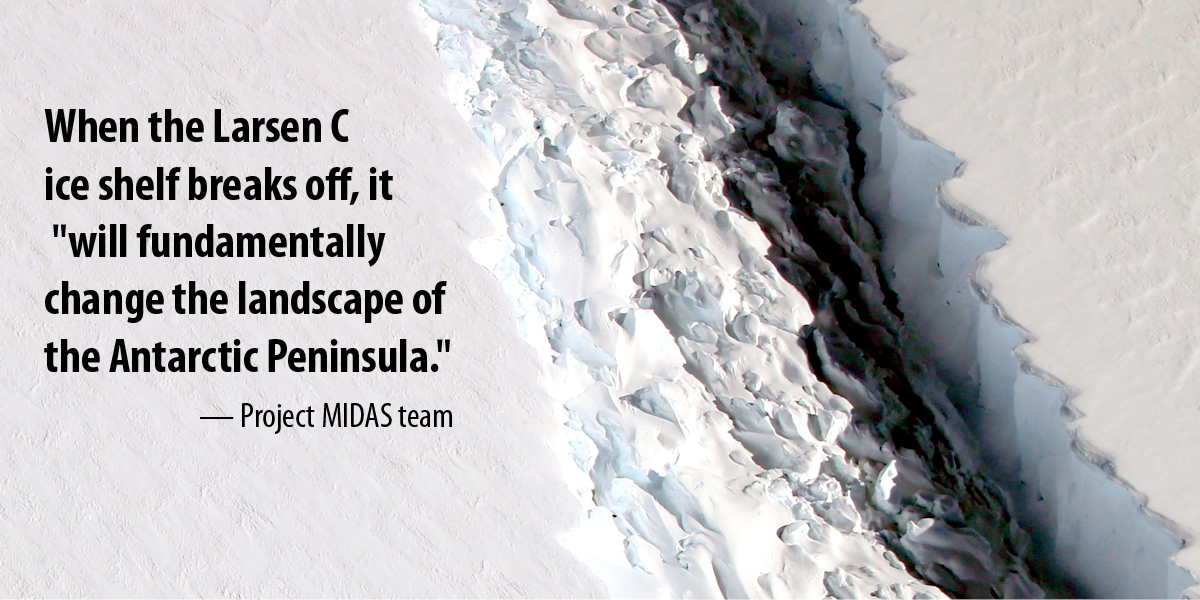

A 70-mile long crack in the Larsen C ice shelf grew another shocking 11 miles in December alone. That leaves just 12 miles before an iceberg the size of Delaware snaps off into the Southern Ocean.
Delaware-Sized Chunk of Ice Could Dislodge from #Antarctic Shelf via @EcoWatch #climate https://t.co/nHjoAThctF
— Dan Zukowski (@danzukowski) August 26, 2016
“The Larsen C Ice shelf in Antarctica is primed to shed an area of more than 5000 square kilometers [approx. 3,100 square miles] following further substantial rift growth,” wrote the Project MIDAS team, which has been studying the ice shelf.
“After a few months of steady, incremental advance since the last event, the rift grew suddenly by a further 18 kilometers [about 11 miles] during the second half of December 2016.”
During the last Antarctic winter, the rift averaged about three miles per month of growth. In December, NASA released a set of images that found the crack measured 70 miles in length, 300 feet wide and one-third of a mile deep.
https://twitter.com/EcoWatch/status/809563783245008898
The sudden acceleration of the split in the ice has scientists convinced that a massive calving event is imminent.
“If it doesn’t go in the next few months, I’ll be amazed,” Professor Adrian Luckman, project leader from Swansea University, told BBC News.
By itself, the iceberg that is set to break off won’t lead to a rise in sea levels, as the ice shelf already floats on the ocean. However, the Larsen ice shelf acts as a buttress against continental glaciers that could then be free to slide into the sea. BBC reports that if all the ice that Larsen C holds back were released into the ocean, global waters would rise by 10 cm, or four inches.
Globally, sea levels have risen about eight inches since 1901. Its effects can be seen in increased flooding in South Florida, coastal erosion in Louisiana, intrusion of seawater into ground aquifers and stronger storm surges such as those seen in Superstorm Sandy.
#Louisiana Faces Faster Levels of Sea-Level Rise Than Any Other Land on Earth https://t.co/zCuAWpcH7U @NRDC @RobertKennedyJr @Waterkeeper
— EcoWatch (@EcoWatch) January 4, 2017
Antarctica—which holds 90 percent of the Earth’s fresh water—is losing about 92 billion tons of ice per year. The rate of loss has doubled from 2003 to 2014.
Long-term satellite observations show that Antarctic glaciers are rapidly retreating. A separate rift in the East Antarctic is forcing a British research station to relocate.
https://twitter.com/EcoWatch/status/573222521736048640
The Larsen C is the latest section of the huge ice shelf to break off. Larsen A collapsed in 1995. In 2002, Larsen B began to break apart. Within six weeks, a 1,235 square mile chunk of ice slipped away.
When the Larsen C ice shelf breaks off, it “will fundamentally change the landscape of the Antarctic Peninsula,” said the U.K.-based Project MIDAS team.

 233k
233k  41k
41k  Subscribe
Subscribe 